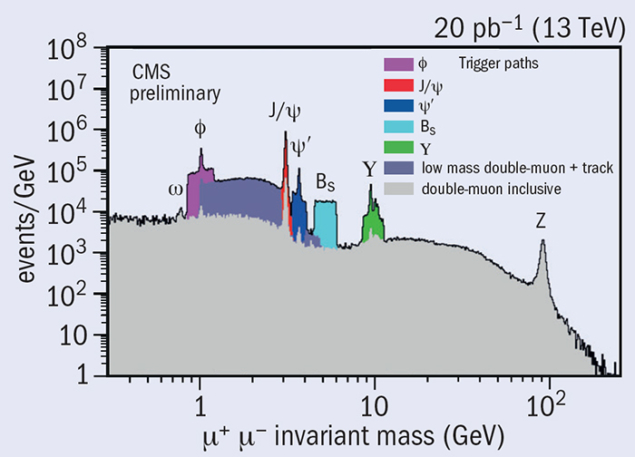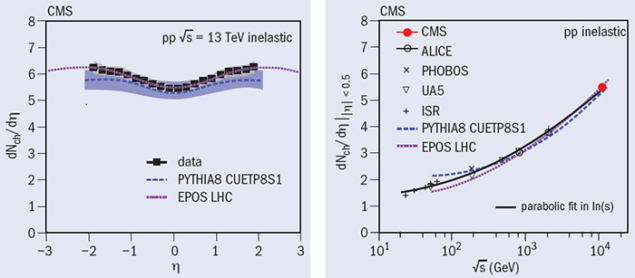
The highlight of EPS-HEP 2015 for the CMS collaboration was the publication of the first physics result exploring the new territory at the LHC energy of 13 TeV: the measurement of the charged-hadron multiplicity (dN/dη), where η, the pseudorapidity, is a measure for the direction of the particle track. When protons collide at the LHC, more than one of their constituents (quarks or gluons) can interact with another one, so every collision produces an underlying spray of charged hadrons, such as pions and kaons, and the greater the energy, the higher the number of produced particles. Knowing precisely how many charged hadrons are created at the new collision energy is important for ensuring that the theoretical models used in the simulations employed in the physics analyses describe these underlying processes accurately. The publication from CMS at 13 TeV reports the differential multiplicity distribution for values of η < 2, and a measured density for central charged hadrons (with |η| < 0.5) of 5.49±0.01 (stat.)±0.17 (syst.). Figure 1 shows the differential distribution and the energy dependence of the new measurement compared with earlier data at lower energies.

CMS has, in addition, produced a full suite of performance plots covering a range of physics objects and final states, using up to 43/pb of 13 TeV data. Figure 2 shows the dimuon mass spectrum obtained from multiple trigger paths, where several resonances from the ω meson to the Z boson can be seen clearly. The B physics group in CMS has studied this spectrum in detail from the J/ψ to the Υ masses, and also the decay-time distributions for events with J/ψ or B+ mesons. Dedicated performance plots were presented at the conference for various muon, electron and photon kinematic and identification variables, as well as the measured reconstruction and identification efficiencies. The reconstruction of several low-mass states, including Ks, Λ, D0, D*, B+, B0 and Bs, demonstrate the good performance of the CMS tracker. In addition, the position of the beam spot has been measured in all three dimensions. Simulations are already found to reproduce these physics-object data well at this early stage.

The physics groups in CMS have also started to study several processes at 13 TeV in some detail. One highlight is a first look for searches in the dijet invariant-mass spectrum, which so far reaches up to approximately 5 TeV (figure 3). Results of the same analysis on Run 1 data were released only in spring, but CMS is already continuing the search where it ended at 8 TeV up to 13 TeV, thus demonstrating the collaboration’s readiness for discovery physics in the new energy regime. The TOP group has studied top–antitop (tt) events in the dilepton and lepton+jet channels, in addition to taking a first look at events consistent with the production of single top quarks.

While eagerly jumping on the new data, CMS continues to produce world-class physics results on the Run 1 data collected at 7 and 8 TeV. The collaboration has recently approved more than 30 new results, which were shown at the conference. These include searches for new physics as well as precision Standard Model measurements. The results presented include measurements of the two-photon production of W-boson pairs through the interaction of two photons, the electroweak production of a W boson accompanied by two jets, production rates for particle jets at 2.76 TeV compared with 8 TeV, as well as the production of two photons along with jets.
Discovered more than two decades ago, the top quark continues to play a vital role in physics analyses for both measurements and searches, because it is the heaviest elementary particle known so far. New CMS results with this special type of quark include measurements of the tt production rates in the fully hadronic sample, and a measurement of the tt+bb process as well as the tt production in conjuction with a Z or W boson. In addition, searches for signs of new physics continue, most recently in the process where top decays to a charm quark and a Higgs boson, t → cH, and the Higgs boson transforms to photons.
On the Higgs front itself, CMS has performed three new searches for non-Standard Model Higgs bosons containing τ leptons in the decay products, while on the supersymmetry front, analyses have looked for dark-matter candidates and other supersymmetric particles. Heavy-ion results from Run 1, using proton–proton, proton–lead and lead–lead collisions, include Υ polarization as a function of charged-particle multiplicity in proton–proton collisions, Z-boson production, jet-fragmentation functions in proton–lead collisions, and nuclear modification of Υ states in lead–lead collisions.





